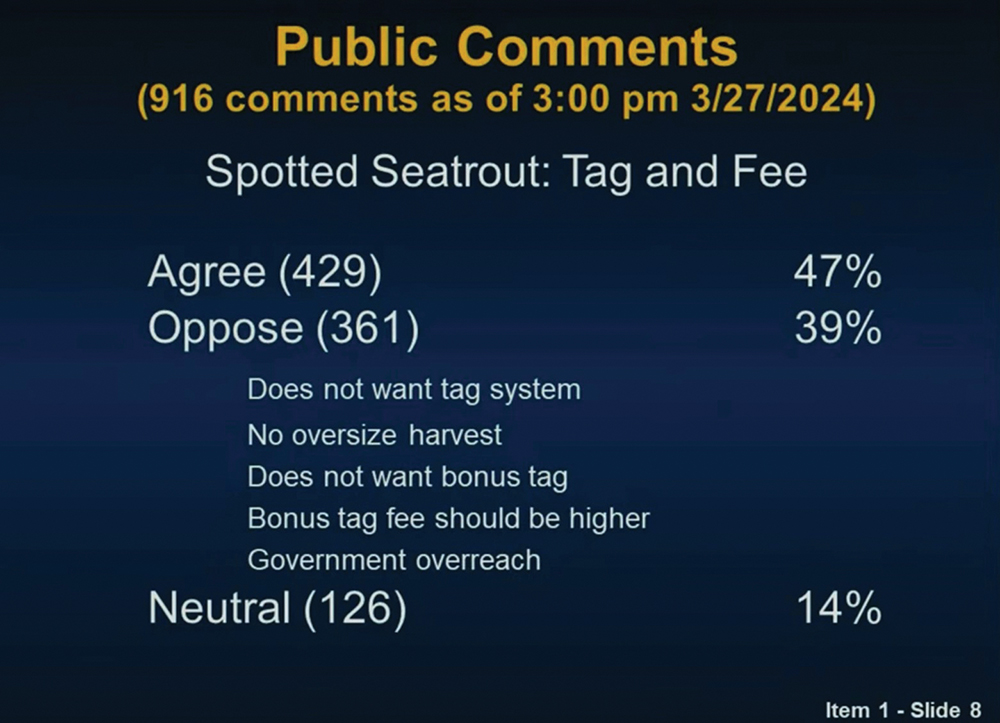Tags for Trout – Texas Leads the Way for Spotted Seatrout Management

In the March 2024 issue of Texas Saltwater Fishing Magazine, we detailed recent alterations in bag and slot limits for Spotted Seatrout, a beloved icon of Texas's coastal fishing scene. Since the late 1970s, this majestic species has evoked passionate support for conservation efforts, a movement that has only gained momentum over the past two decades, marked by intensified fingerling stockings, habitat restoration, and a series of regulatory adjustments.
In a decisive move in late January, the Texas Parks and Wildlife Commission (TPWC) approved the proposal to lower the daily bag limit to three fish, coupled with a slot limit spanning 15 to 20 inches, and allowance of one fish 30-inches or greater as part of the 3-fish bag. This revision superseded previous regulations, where anglers could retain a fish exceeding 25 inches per day, with a bag limit of five fish and a slot range of 15 to 25 inches. These regulatory modifications, effective since March 26th, are forecasted by the Texas Parks and Wildlife Department (TPWD) to bolster spawning stock biomass by a substantial 27% over a single generation of trout.
Following swiftly on the heels of these changes, on March 28th, the TPWC endorsed a tagging system tailored for oversized Spotted Seatrout. This innovative measure, slated for implementation in the upcoming license year, will exclude oversized Spotted Seatrout from the daily bag limit. Beginning September 1, 2024, anglers will be required to utilize a tag, included with their fishing license, to retain a single fish 28 inches or greater on an annual basis. Additionally, anglers will have the option to procure a bonus tag for a nominal fee of $3, facilitating the retention of a second oversized fish per annum. This tagging protocol mirrors the existing framework governing red drum, underscoring its significance for the recreational fishing landscape along the Texas coast.
Throughout the regulatory deliberations spanning from late 2023 to March 2024, CCA Texas steadfastly advocated for the implementation of a tagging system targeting Spotted Seatrout measuring 25 inches or greater—an earnest endeavor to strike a harmonious balance between conservation imperatives and angling opportunities. It is no secret that many anglers want to see more trophy fish in their bays, and some feared a regression in Spotted Seatrout populations once temporary regulations, enacted in the aftermath of the February 2021 freeze, were rescinded. This sentiment was overwhelmingly expressed during the TPWD annual public hearing held in August 2023 and at subsequent public comment opportunities. While signs of regional recovery (lower coast) have surfaced post-freeze, recent TPWD spring gill net surveys reveal diminished catch rates compared to pre-freeze levels, both in terms of coastwide averages and within specific bay systems (e.g., Matagorda Bay and San Antonio Bay).
In an effort to balance conservation and opportunity, the TPWC judiciously refined the proposal, lowering the threshold for oversized tagging from 30 inches to 28 inches, a decision underpinned by considerations of biological impact and pragmatic simplicity. "Biologically, the impact is de minimis—we're talking 2 inches," asserted Dakus Geeslin, deputy director of the TPWD coastal fisheries division, during a pivotal commission session.
Initially, the proposed regulations would have imposed a moratorium on the harvest of oversized Spotted Seatrout during the interim period between rule adoption and implementation on September 1, effectively prohibiting their capture until the tagging system was operationalized. However, the commission opted for a modified simplistic approach, preserving the extant daily bag limit (including the provision for one fish over 30 inches) until the issuance of tags. Geeslin articulated the rationale behind this decision, suggesting that maintaining the status quo until September 1 would have negligible repercussions on the Spotted Seatrout population.
Statistical insights gleaned from TPWD's creel surveys provide further context, revealing that while larger trout constitute a minority within the Spotted Seatrout population, they hold immense value for us saltwater anglers. By safeguarding these prized specimens and preserving their presence in our coastal waters, we extend invaluable opportunities for anglers to hook their dream catch. Geeslin underscored this sentiment during a public hearing, expressing optimism that sustained protection of larger trout would not only fortify their numbers but also enhance the likelihood of anglers encountering a trophy-worthy specimen—a testament to the enduring allure of Texas's vibrant fishing heritage.

